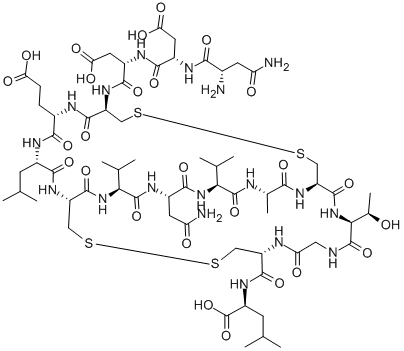|
|
| Product Name: | Uroguanylin (human) | | Synonyms: | UGN (HUMAN);UROGUANYLIN;UROGUANYLIN (HUMAN);asn-asp-asp-cys-glu-leu-cys-val-asn-val-ala-cys-thr-gly-cys-leu [disulfide bridges: 4-12, 7-15];H-ASN-ASP-ASP-CYS-GLU-LEU-CYS-VAL-ASN-VAL-ALA-CYS-THR-GLY-CYS-LEU-OH;H-ASN-ASP-ASP-CYS-GLU-LEU-CYS-VAL-ASN-VAL-ALA-CYS-THR-GLY-CYS-LEU-OH, (DISULFIDE BONDS BETWEEN CYS4 AND CYS12/CYS7 AND CYS15);ASN-ASP-ASP-CYS-GLU-LEU-CYS-VAL-ASN-VAL-ALA-CYS-THR-GLY-CYS-LEU;ASN-ASP-ASP-CYS-GLU-LEU-CYS-VAL-ASN-VAL-ALA-CYS-THR- GLY-CYS-LEU(DISULFIDE BRIDGE: CYS4-CYS12, CYS7-CYS15) | | CAS: | 154525-25-4 | | MF: | C64H102N18O26S4 | | MW: | 1667.86 | | EINECS: | | | Product Categories: | Peptide | | Mol File: | 154525-25-4.mol |  |
| | Uroguanylin (human) Chemical Properties |
| Boiling point | 2112.5±65.0 °C(Predicted) | | density | 1.48±0.1 g/cm3(Predicted) | | storage temp. | −20°C | | form | powder | | pka | 3.61±0.21(Predicted) | | color | white |
| | Uroguanylin (human) Usage And Synthesis |
| Discovery | UGN was first isolated from opossum urine in 1993
and was identified in humans in 1994. In nonmammals,
ugn was first cloned from the eel in 2001. Also, in other
vertebrates, ugn has been found. An ugn-like sequence is
observed in the nucleotide database of an invertebrate,
Ciona intestinalis. lgn was first cloned from the opossum
in 1999. | | Structure | UGN consists of 15–17 aa residues that are released
from the C-terminus of proUGN. The
fourth and 12th Cys and the seventh and 15th Cys form
a disulfide bond, respectively, and the two
rings give rise to the formation of two stereoisomers, of
which only one is active. Some UGNs have a
C-terminal extension , which may contribute
to stabilizing the active isomer. The ninth aa residue is
nonaromatic and thus resistant to chymotrypsin-like proteases in the renal tubule. These features
are shared among all UGNs found. Lgn possesses a nonaromatic aa residue at the same position, but lacks the
15th Cys residue, resulting in the lack of the second disulfide ring. Most of the 15–17 aa residues are conserved across vertebrate species, though some are different, especially in
Lgn. In some species, 1–2 extra aa residues
are present at the C-terminus. The prosegment is variable
except for the conserved Leu/Lys-rich region located in
the upstream of proUGN.
 | | Properties | Mr and pI of human UGN are 1667.9 and 3.19, respectively. UGN is soluble in water, alcohol, and watercontaining organic solvent. UGN in solution is stable at
neutral pH. UGN in water is stable at -20°C for more
than 1 year. Solubilization and storage methods of Lgn
may be similar to those of UGN. | | Gene, mRNA, and precursor | In humans, UGN consisting of three exons is located on
chromosome 1 (1p34.2) with GN. Similar colocalization
on a chromosome is observed in other vertebrate species.
The translated preproUGN of 112 aa residues contains
the signal peptide and the mature peptide. ProUGN is released from cells and processed
into UGN during circulation or on the intestinal and renal
tubular lumen. The mature region is well or moderately
conserved among vertebrate UGNs or in opossum Lgn,
respectively , although the precise processing mechanism needs to be investigated in
nonmammalian Ugns. A splice variant is suggested in
the European eel. | | Receptors | GUCY2C, a membrane protein consisting of an extracellular ligand-binding domain, a membrane-spanning
domain, a kinase-like domain, and a cyclase catalytic
domain, is the primary receptor for both UGN and GN .A shorter GUCY2C, a splice variant,
is expressed in some colorectal cancer cells. In contrast
to one GUCY2C in mammals, at least two gucy2c exist
in teleost fish. In eels, at the cGMP production, Gucy2c1 is stimulated primarily by Ugn while
Gucy2c2 responds to Ugn less effectively than Gn Structure of human preproUGN (A) and UGN (B), and comparison of vertebrate UGN and opossum Lgn (C). (B) The schematic view
is based on previous reports. (C) Arrowheads indicate the ninth aa residue characteristic to UGN.
350 32B. At least one gucy2c sequence has been found in
other vertebrates. Furthermore, another type of GC
receptor, GUCY2D, expressing in the murine olfactory
epithelia, is reported to be stimulated by GN and UGN.
The presence of additional UGN receptor(s) has been
predicted. In the opossum, Gucy2c is also a receptor
for Lgn. | | Agonists | Sts produced by enterotoxigenic E. coli are exogenous
ligands of GUCY2C. Sts exert stronger effects for
GUCY2C than UGN in mammals and substantial effects
for one medaka Gucy2c (Olgc9), but not for other fish
cloned Gucy2cs. Other major agonists are synthetic
peptides modified from GN/UGN, linaclotide and
plecanatide. | | Clinical implications | There is no known disease related to UGN. A function
for the intestinal fluid secretion has led scientists to apply
UGN for anticonstipation. The facts of decreased UGN
mRNA expression in some colorectal cancers and promoted epithelial proliferation in the loss of UGN suggest
a clinical application of UGN to prevent the enlargement
of colorectal tumors. The evidence of decreased UGN in
obesity and the implication of UGN as an enterocerebral
natriuretic factor could also be keys for UGN-utilizing
improvement of obesity. | | General Description | Uroguanylin is a peptide hormone consisting of 15–17 aa residues
that binds to the guanylyl cyclase C (GUCY2C) receptor to
produce cGMP, which is often more effective than guanylin
(GN). It plays important roles in regulating ion and water
transport and maintaining epithelial homeostasis in the intestine and kidney. Opossum lymphoguanylin (Lgn) is more
similar to UGN than to GN, and thus, is described here. | | Biological Activity | Stimulates intestinal guanylate cyclase. | | Clinical Use | Two UGN/GN agonists, linaclotide and plecanatide,
have recently been approved in the United States, European Union, Japan, and other countries for treatment of
irritable bowel syndrome and chronic constipation. They
have also been approved in the United States for treatment of chronic idiopathic constipation and irritable
bowel syndrome with constipation, respectively. |
| | Uroguanylin (human) Preparation Products And Raw materials |
|